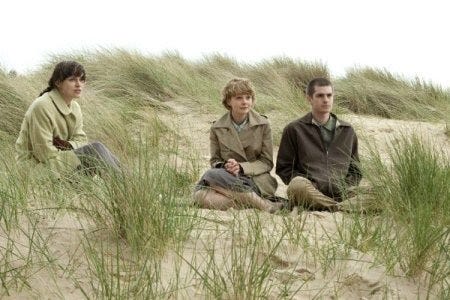Week Three of Never Let Me Go: "It felt like the three of us were close again"
On triangular relationships creating propulsion and tension
Welcome to Week Three of reading Never Let Me Go in honor of its twentieth anniversary! I’m posting a little earlier this week in preparation for a special post for tomorrow. You can read the Announcement, Kickoff, Week One, and Week Two posts if you need to catch up.

A non-exhaustive recap of Chapters Ten through Seventeen
There’s a beautiful, simple structure to this novel. Part One covers their youth and adolescence at Hailsham, and ends when they leave Hailsham for the Cottages. Part Two effectively covers their young adulthood at the Cottages, with the centerpiece as the trip to Norfolk.
In Chapter Twelve, we learn about the students’ fixation on their “models” or “possibles”—that is, the people from whom they were cloned for the purpose of donating their organs. We don’t get the first mention of the word clone until Chapter Fourteen, though, when Ruth says:
We’re modelled from trash. Junkies, prostitutes, winos, tramps. Convicts, maybe, just so long as they aren’t psychos. That’s what we come from . . . The other woman in there, her friend, the old one in the gallery. Art students, that’s what she thought we were. Do you think she’d have talked to use like that if she’d known what we really were? What do you think she’d have said if we’d asked her? ‘Excuse me, but do you think your friend was ever a clone model?’
Throughout Chapters Thirteen through Fifteen, our trio takes a trip to Norfolk in search of Ruth’s “possible.” We realize, too, that the older students have brought the trio along to discuss the rumor of “deferrals,” the idea that if two students are provably in love, they can defer their organ donations for a few years. And Tommy theorizes with Kathy that the deferral rumor is real, but that in order to qualify, the Hailsham guardians will examine the art they created as children—which rules Tommy out.
On beginning with relationships
I linked to Kazuo Ishiguro’s Nobel Prize lecture a few posts back, but I wanted to return to it for this section because Ishiguro speaks about the centrality of relationships in his writing. As I read Part Two, I kept thinking about his words. Apologies for the block quote, but this passage is so wonderful:
Couldn't I . . . hold up to the light the various relationships that criss-cross any story? Could I do this with my own work – to stories I'd completed and ones I was planning? I could look at, say, this mentor-pupil relationship. Does it say something insightful and fresh? Or now that I was staring at it, does it become obvious it's a tired stereotype, identical to those found in hundreds of mediocre stories? Or this relationship between two competitive friends: is it dynamic? Does it have emotional resonance? Does it evolve? Does it surprise convincingly? Is it three-dimensional?
I suddenly felt I understood better why in the past various aspects of my work had failed, despite my applying desperate remedies. The thought came to me . . . that all good stories, never mind how radical or traditional their mode of telling, had to contain relationships that are important to us; that move us, amuse us, anger us, surprise us. Perhaps in future, if I attended more to my relationships, my characters would take care of themselves.
He goes on to explain how he applied this approach specifically to Never Let Me Go:
From then on, I began to build my stories in a different way. When writing my novel Never Let Me Go, for instance, I set off from the start by thinking about its central relationships triangle, and then the other relationships that fanned out from it.
I think that focus is very apparent in Part Two—and particularly effective. After all, Part Two involves many big speculative-type reveals (they’re clones, they might be able to get deferrals, the focus on art at Hailsham may be related to the deferrals) and sets up the big challenge for our trio (seeking out Madame to obtain a deferral). Of course, those speculative challenges fuel much of the propulsion of this section.
Despite the speculative elements, this section remains very grounded due to the “central relationships triangle.” And besides the bigger, more sci-fi drama playing out around the characters, Part Two benefits from small-scape propulsion through the constant shifting and recombining of the trio. Ruth cutting Kathy and Tommy out of the conversation in the car; Kathy siding with Ruth against Tommy when he doesn’t know what the deferrals are; Tommy joining Kathy when Ruth gets upset; Ruth turning against Kathy and drawing Tommy to her team.
On dynamic, triangular relationships
When I was reading Part Two and thinking up this post, I started considering the inherent dynamism of triangular relationships. Triangular relationships by definition lead to conflict and tension through the endless combining and recombining of your trio, which is why love triangles are so common in stories. Psychologists also write about the inherent tension involved in triangular relationships, for example here. As one Georgetown University-supported program writes:
A triangle can contain much more tension [than a dyad] because the tension can shift around three relationships. . . . A triangle creates an odd person out, which is a difficult position for individuals to tolerate. Anxiety generated by being or anticipating being the odd person out is a potent force in triangles. The patterns in a triangle change with increasing tension. In calm periods, two people are comfortably close “insiders” and the third person is an uncomfortable “outsider.” The insiders actively exclude the outsider, and the outsider may feel rejected and work to get closer to one of them. Someone is always uncomfortable in a triangle and pushing for change. The insiders solidify their bond by choosing each other in preference to the less desirable outsider.
That’s a brilliant structure for plot tension and drama. What I like about Never Let Me Go is that it’s not a love triangle, really, but about a complicated lifelong friendship. And Part Two of Never Let Me Go shows the ways that you can play with all those possible combinations:
A, B, and C all apart;
A versus B and C;
A and B versus C;
A and C versus B; and
A, B, and C united.
In fact, in Part Two we get all of these combinations, which creates a lovely structure to the section. We begin Norfolk trip with all three of our trio apart, exemplified by their isolation and separation in the car on the way to Norfolk. During the trip, we get all the recombinations. And finally we return from Norfolk with our trio united:
On that long journey home, with the darkness setting in over those long empty roads, it felt like the three of us were close again and I didn’t want anything to come along and break that mood.
That reunification of the trio really feels very complete, like a chord resolving in a musical progression. It provides a satisfying moment of rest for the reader, doesn’t it?
Of course, that unified front doesn’t last for long. It flies apart in Chapter Sixteen and Seventeen. That dissembling will catapult us into the final Part Three, along with the more speculative mysteries we have yet to solve. Along with the more speculative question of will they get a deferral? the plot is propelled by the question of will the trio reunite before it’s too late? As Kathy says:
But the fact was, I suppose, there were powerful tides tugging us apart by then, and it only needed something like that to finish the task. If we’d understood that back then—who knows?—maybe we’d have kept a tighter hold of one another.
In short, I'm very inspired by how Part Two—and this entire novel—offer a brilliant example of starting with relationships and working outward, and how triangular relationships can fuel so much human-level propulsion in a story.
Up Next: Reading to the end!
Extra-Credit Reading
I really liked this note I took from “Writing With Care: Kazuo Ishiguro’s Never Let Me Go,” in which Anne Whitehead writes:
[Kathy's] preoccupations with professional success and with minor inconsistencies in the system mean that she is not addressing either her own imminent death or the larger inequities and injustices at work. . . . Is “caring,” viewed in this light, a form of labor that is socially valuable because Kathy is making a positive difference to others (preventing "agitation"), or—given the political resonances of Ishiguro's choice of word here—is it a means of preventing resistance and unrest?
The Remains of the Schedule
Week Four (Tuesday, June 3 to Monday, June 10): Chapters Eighteen through the end










I'm still on chapter 7. Just found out the big reveal of what are donors. Arhhh! That is terrible news!